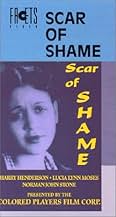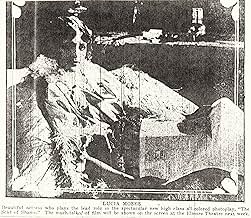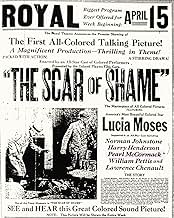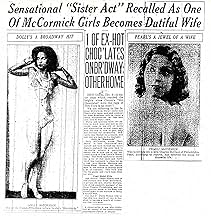Füge eine Handlung in deiner Sprache hinzuA black musician marries a woman facing abuse from her stepfather to rescue her. After the marriage, he refuses to introduce her to his mother, fearing his mother's disapproval of her lower ... Alles lesenA black musician marries a woman facing abuse from her stepfather to rescue her. After the marriage, he refuses to introduce her to his mother, fearing his mother's disapproval of her lower socioeconomic status.A black musician marries a woman facing abuse from her stepfather to rescue her. After the marriage, he refuses to introduce her to his mother, fearing his mother's disapproval of her lower socioeconomic status.
- Auszeichnungen
- 1 Nominierung insgesamt
Charles Gilpin
- Lido Club Gambler
- (Nicht genannt)
Shingzie Howard
- Louise's Maid
- (Nicht genannt)
Empfohlene Bewertungen
OK first of all let's face it. Some films during the silent era can be boring and painful to actually get into, but are more worth the watch for the visuals of what things were like back then. I personally like watching them because there aren't a crazy amount of them left and it is fun to fantasize what it would have been like back then. I always feel like there are not enough words to justify having words at all during the films. This film is a silent black film with a great story. It doesn't put you to sleep and it has some powerful silent acting along with a powerful story about class. (This movie is called a race film bc it was a film made for black people starring black people. It does not mean that this movie is about racial issues with other races, but about a couple who marries each other outside of their classes and how the female lead has a very difficult time adjusting to a higher class life.) It is definitely worth the watch. It is very sad how many very early films such as this did not make it through the years. Watch them and appreciate them.
Monday February 6, 7:00pm The Paramount Theater
In a contemporary study of film history The Scar of Shame (1927) has great value as an early surviving example of the "Race Movie" genre. These were motion pictures produced from the silent era through the nineteen-forties using black actors for a black audience in a racially segregated market. Race movies were screened in the schools and churches of small towns as well as theaters in larger cities. The films of Oscar Micheaux were of particular significance in the early days of the genre. "The Scar of Shame" was one of four films produced by The Colored Film Players Corporation of Philadelphia. Harry Henderson (Alvin Hillyard) is a well-educated musician with high aspirations. In an act of altruism he marries Louise Howard (Lucia Lynn Moses) to save her from her abusive Stepfather but is ashamed to take her home to his Mother because she not "in our set". Essentially a well executed melodrama, "The Scar of Shame " is noteworthy for its high production values which indicate a larger than typical budget, as well as elements of colorism and classism.
In a contemporary study of film history The Scar of Shame (1927) has great value as an early surviving example of the "Race Movie" genre. These were motion pictures produced from the silent era through the nineteen-forties using black actors for a black audience in a racially segregated market. Race movies were screened in the schools and churches of small towns as well as theaters in larger cities. The films of Oscar Micheaux were of particular significance in the early days of the genre. "The Scar of Shame" was one of four films produced by The Colored Film Players Corporation of Philadelphia. Harry Henderson (Alvin Hillyard) is a well-educated musician with high aspirations. In an act of altruism he marries Louise Howard (Lucia Lynn Moses) to save her from her abusive Stepfather but is ashamed to take her home to his Mother because she not "in our set". Essentially a well executed melodrama, "The Scar of Shame " is noteworthy for its high production values which indicate a larger than typical budget, as well as elements of colorism and classism.
An all black silent film made exclusively for black audiences in the 1920s (back then theatres were segregated). Poor but beautiful Louise Howard (Lucia Lynn Moses) is beaten by her stepfather (William E Pettus) but dreams of a better life. She meets good honest Alvin Hillyard (Harry Henderson) and he falls in love with her. But her stepfather and evil Eddie Blake (Norman Johnson) aren't going to let her go without a fight.
Interesting from a historical standpoint and not too bad as a drama either. It does get overly melodramatic with a lot of eye-rolling speeches and gets more than a little ridiculous during it's last half hour but I was never bored. The acting is actually pretty good and it moves quickly. Also the cards telling us what's going on have some interesting designs. When Blake is introduced there's a wolf shown on the title card! So, a pretty good movie. Also interesting to see how blacks were shown and treated back then. A 7.
Interesting from a historical standpoint and not too bad as a drama either. It does get overly melodramatic with a lot of eye-rolling speeches and gets more than a little ridiculous during it's last half hour but I was never bored. The acting is actually pretty good and it moves quickly. Also the cards telling us what's going on have some interesting designs. When Blake is introduced there's a wolf shown on the title card! So, a pretty good movie. Also interesting to see how blacks were shown and treated back then. A 7.
An effective tragedy that demonstrates the importance of environment in shaping the lives of people.
I enjoyed this race movie intended for black audiences, even though I am not African-American or any racial minority. The forward states its point of view that a poor environment for a child will inevitably bring on a sense of shame, and then proceeds to unfold its story of an educated man in the field of music marrying a lower class woman to protect her from her stepfather, who beats her. Problems arise, however, when he won't take her to see his mother, who doesn't know he got married, and who he knows will be disappointed he did not marry a girl from his own class. My only problem with the movie was in the casting of the very refined Lucia Lynn Moses as the woman, so I could not fathom why her husband, well played by Harry Henderson, would not want his mother to meet her. It's an old-fashioned movie with some old-fashioned ideas, but has a few twists and wound up producing a few tears in my eyes. Watch it with some hankies close by if you are a softy for such movies, like me.
Despite having an all African-American cast, this film doesn't deal explicitly with race, as its script could have been applied to white people, which is a nice thing for 1927. The film is in part about the dynamic between social classes, and has some good early scenes that deal with that. In one, we see the intertitle "One half the world doesn't know how the other half lives" while a poor woman is scrubbing the laundry over a washboard. Eventually it gets a little bit pushy in its message, which is for people to choose higher aspirations in life (education, the arts, steady jobs) vs. lower (gambling, drinking, violence), making it a simplistic morality tale, and one that is of course directed at the African-American community.
In that sense, it has everything to do with race, and says (1) look, we're people too, not the stereotypes Hollywood and white supremacist culture ordinarily portrays us to be (2) we can do better, that "Our people have much to learn." The plot and the love triangle which develops in the second half is more than a little melodramatic, but the screen presence of all three leads is undeniable (Harry Henderson, Lucia Lynn Moses, and Pearl McCormack), and had these actors been white they all might have been stars of the era. The film is pretty well made as well, making it a silent worth checking out.
In that sense, it has everything to do with race, and says (1) look, we're people too, not the stereotypes Hollywood and white supremacist culture ordinarily portrays us to be (2) we can do better, that "Our people have much to learn." The plot and the love triangle which develops in the second half is more than a little melodramatic, but the screen presence of all three leads is undeniable (Harry Henderson, Lucia Lynn Moses, and Pearl McCormack), and had these actors been white they all might have been stars of the era. The film is pretty well made as well, making it a silent worth checking out.
Wusstest du schon
- WissenswertesFilm scholar Donald Bogle called this movie quite possibly the best independent black film of the silent era.
- PatzerAfter Alvin leaves his mother's house, the butler reaches down to pick up the dropped key with his left hand, the next shot is a closeup of him picking up the key with his right hand. The next shot he is standing up with the key in his left hand.
- Zitate
Title Card: One half the world doesn't know how the other half lives.
- Alternative VersionenThe Library of Congress Video Collection has a restored version of this film with a new piano score composed and performed by Philip Carli. Its running time is 76 minutes. A small missing section is summarized by an intertitle. Other restoration credits: Simmon, Scott ....... restoration producer Fleming, Dina T. .... restoration production co-ordinator McConnell, Allan .... restoration magnetic recording laboratory head Winther, James ...... restoration videotape transfer and editor Chrisman, Paul ...... restoration music recordist DeAnna, Gene ........ restoration titles
- VerbindungenFeatured in American Experience: Midnight Ramble (1994)
Top-Auswahl
Melde dich zum Bewerten an und greife auf die Watchlist für personalisierte Empfehlungen zu.
Details
- Laufzeit
- 1 Std. 8 Min.(68 min)
- Farbe
- Sound-Mix
- Seitenverhältnis
- 1.33 : 1
Zu dieser Seite beitragen
Bearbeitung vorschlagen oder fehlenden Inhalt hinzufügen

















